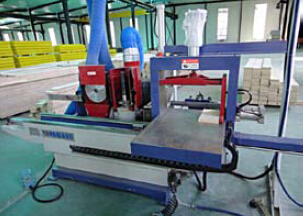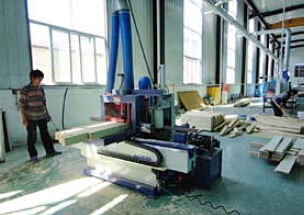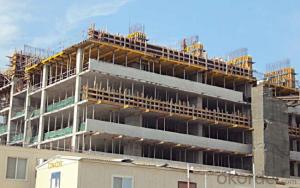Timber-Beam Formwork and H20 for Formwork and scaffolding system
- Loading Port:
- Tianjin
- Payment Terms:
- TT OR LC
- Min Order Qty:
- 50 m²
- Supply Capability:
- 1000 m²/month
OKorder Service Pledge
Quality Product, Order Online Tracking, Timely Delivery
OKorder Financial Service
Credit Rating, Credit Services, Credit Purchasing
You Might Also Like
Characteristics:
◆ Standardized production lines.
Supply capability: 3000m/day, Lmax = 6600mm.
◆ Finger jointing of the flange and web, the strength of timber beam is highly improved.
Max. shearing force failure load:40KN
◆ Well treated to prevent from water penetration or erosion, so the service life maximally
extended.
Normally, CNBM timber beam H20 can be used for 4 to 5 years, the exact using time would
depend on maintenance & storage.
◆ Robust caps at the end of the girders protect against damages.




- Q:How does steel formwork affect the construction timeline?
- Steel formwork can have a significant impact on the construction timeline in both positive and negative ways. One of the main advantages of using steel formwork is its durability and strength. Unlike traditional wooden formwork, steel formwork can withstand multiple uses without losing its structural integrity. This means that it can be reused many times, reducing the time and effort required to set up formwork for subsequent construction phases. Additionally, steel formwork allows for faster assembly and disassembly, which can help to expedite construction timelines. Furthermore, steel formwork provides a high level of accuracy and consistency in shaping concrete structures. The precise dimensions and smooth finish achieved with steel formwork ensure that the construction process proceeds smoothly without any delays caused by rework or adjustments. This can lead to faster completion of construction projects. On the other hand, steel formwork can also introduce certain challenges that may affect the construction timeline. Firstly, steel formwork is generally heavier and requires more effort to transport and handle compared to other types of formwork. This may slow down the overall construction process, especially if there are limitations in terms of available equipment or labor. Additionally, steel formwork may require additional time for installation and dismantling compared to other formwork systems. The complexity of steel formwork systems and the need for skilled workers to handle them can result in a longer setup and removal time. This can impact the overall construction timeline, particularly when tight deadlines need to be met. In conclusion, steel formwork can have both positive and negative effects on the construction timeline. Its durability, reusability, and accuracy can help expedite the construction process. However, the weight and complexity of steel formwork may introduce additional challenges that can potentially slow down the construction timeline.
- Q:How does steel formwork handle construction joints?
- Steel formwork is a versatile and durable option for handling construction joints. It is specifically designed to handle the demands of construction joints and ensure a seamless and efficient construction process. Firstly, steel formwork is known for its strength and stability, which allows it to withstand the pressure and weight exerted on construction joints. This ensures that the formwork remains intact and in place, even when concrete is poured and compacted at the joints. Additionally, steel formwork is highly flexible and can be easily adjusted to accommodate various shapes and sizes of construction joints. This allows for precise and accurate placement of the formwork, ensuring that the joints are properly formed and aligned. Moreover, steel formwork is reusable, which makes it a cost-effective option for handling construction joints. Once the concrete has cured and the formwork is removed, it can be cleaned, repaired if necessary, and used again for subsequent construction projects. This reduces the need for additional formwork materials and minimizes waste. Furthermore, steel formwork provides a smooth and even surface finish, which is crucial for construction joints. It helps to prevent any leakage or seepage of concrete at the joints, ensuring that the structure remains watertight and structurally sound. In conclusion, steel formwork is an excellent choice for handling construction joints. Its strength, flexibility, reusability, and ability to provide a smooth surface finish make it a reliable and efficient solution for construction projects of all sizes and complexities.
- Q:How does steel formwork compare to other formwork materials in terms of cost?
- Steel formwork is generally more expensive compared to other formwork materials such as wood or plastic. However, it offers numerous advantages including durability, reusability, and better structural stability, which can offset the initial higher cost in the long run.
- Q:Types of building templates? What is clear water template?
- Bamboo plywood template: is the earliest use of plain bamboo plywood template, has developed a bamboo bamboo plywood coated template, bamboo plywood, wood coating or coating bamboo plywood etc.
- Q:Can steel formwork be easily disassembled and removed after construction?
- Certainly! After construction, it is possible to easily disassemble and remove steel formwork. These formwork systems are specifically designed to be reusable and offer great flexibility when it comes to assembly and disassembly. Typically, the components of steel formwork are lightweight, making them easily manageable and movable by construction workers. Furthermore, steel formwork systems often incorporate adjustable clamps and brackets, enabling swift and efficient dismantling. This not only saves time and labor costs but also permits the reuse of the formwork in future construction endeavors, making it an environmentally-friendly and cost-effective option for construction projects.
- Q:How does steel formwork accommodate for different concrete curing temperatures?
- Steel formwork is a versatile and reliable option for accommodating different concrete curing temperatures. The main advantage of steel formwork is its high thermal conductivity, allowing it to effectively dissipate heat from the curing concrete. This property enables the steel formwork to regulate the temperature of the concrete during the curing process. In situations where the concrete curing temperature needs to be controlled, steel formwork can be equipped with additional features to accommodate these requirements. For instance, insulation materials can be applied to the steel formwork to minimize heat loss or gain, ensuring a steady and consistent curing temperature. This is particularly useful in extreme weather conditions, where the ambient temperature can significantly impact the curing process. Moreover, steel formwork can also be used in conjunction with heating or cooling systems to further regulate the concrete curing temperature. For example, in cold weather conditions, heating elements can be integrated into the steel formwork to maintain a favorable temperature for proper curing. Similarly, in hot weather conditions, cooling systems can be employed to prevent excessive heat from affecting the curing process. Additionally, steel formwork offers excellent strength and durability, which is crucial for accommodating different concrete curing temperatures. The robust nature of steel formwork allows it to withstand the pressure and stresses exerted by the curing concrete, regardless of the temperature. This ensures that the formwork remains intact and stable throughout the curing process, preventing any deformations or failures that may compromise the quality of the concrete structure. Overall, steel formwork is an ideal choice for accommodating different concrete curing temperatures due to its high thermal conductivity, adaptability to insulation materials, and compatibility with heating or cooling systems. Its strength and durability further enhance its ability to withstand the challenges posed by varying curing temperatures, ensuring the successful and optimal curing of the concrete.
- Q:Can steel formwork be used for architectural concrete walls with complex geometries?
- Yes, steel formwork can be used for architectural concrete walls with complex geometries. Steel formwork offers several advantages for such applications. It is highly durable and can withstand the pressure exerted by the concrete during pouring and curing. Steel formwork also provides excellent dimensional accuracy, ensuring that the concrete walls are built according to the desired complex geometries. Moreover, steel formwork allows for easy customization and flexibility in design. It can be easily fabricated into various shapes and sizes, enabling architects to create intricate and unique architectural concrete walls. Steel formwork also offers a smooth and uniform finish to the concrete, resulting in aesthetically pleasing walls. Additionally, steel formwork is reusable, making it a cost-effective choice for projects with complex geometries. It can be dismantled and used for multiple projects, reducing the overall construction costs. Steel formwork is also easy to clean and maintain, further enhancing its usability and longevity. In conclusion, steel formwork is an ideal choice for architectural concrete walls with complex geometries. It provides strength, durability, dimensional accuracy, customization options, and cost-effectiveness, making it a suitable solution for constructing visually appealing and structurally sound concrete walls.
- Q:What are the considerations when designing steel formwork for stairs?
- When designing steel formwork for stairs, several important considerations need to be taken into account. Firstly, the structural integrity and load-bearing capacity of the formwork must be carefully evaluated to ensure it can support the weight of workers, materials, and any equipment used during the construction process. Additionally, the formwork should be designed to provide sufficient stability and rigidity to prevent any deformation or movement during concrete pouring and curing. The dimensions and shape of the stairs, including the riser and tread dimensions, should be accurately calculated to meet safety and accessibility standards. Lastly, attention should be given to ease of assembly, disassembly, and reusability of the formwork to optimize efficiency and cost-effectiveness in construction projects.
- Q:How does steel formwork contribute to the construction process?
- Steel formwork is a crucial component in the construction process as it plays a significant role in shaping and supporting concrete structures. It is used for forming walls, columns, beams, and slabs, providing the necessary support during the pouring and curing of concrete. One major contribution of steel formwork is its strength and durability. Steel is known for its high tensile strength, which allows it to withstand the pressure exerted by the weight of the concrete. This strength ensures that the formwork remains intact and stable, preventing any deformation or collapse during the construction process. Additionally, steel formwork is highly versatile and can be customized to any desired shape or size. This flexibility enables architects and engineers to create complex and unique structures that would be difficult to achieve with other formwork materials. The ability to shape the formwork according to specific design requirements ensures that the final concrete structure is not only functional but also aesthetically pleasing. Moreover, steel formwork offers excellent reusability. Unlike other formwork materials such as wood or plywood, steel formwork can be reused multiple times without compromising its structural integrity. This reusability factor not only reduces construction costs but also minimizes waste and promotes sustainability in the construction industry. Another advantage of steel formwork is its ease of assembly and disassembly. It can be quickly installed and dismantled, allowing for faster construction cycles. This efficiency saves time and labor, leading to increased productivity and overall cost savings on construction projects. Furthermore, steel formwork provides a smooth and consistent finish to the concrete surface. The steel panels are designed to be impermeable, preventing any leakage or seepage of concrete. This feature ensures that the concrete cures uniformly, resulting in a high-quality finish that meets the desired specifications. In conclusion, steel formwork significantly contributes to the construction process by providing strength, durability, versatility, reusability, ease of assembly, and a smooth finish to concrete structures. Its essential role in shaping and supporting concrete elements makes it an indispensable tool for modern construction projects.
- Q:Can steel formwork be used for foundation construction?
- Yes, steel formwork can be used for foundation construction. Steel formwork is a versatile and durable option for constructing foundations. It provides a strong and stable support system for pouring concrete and creating the desired shape and structure of the foundation. Steel formwork offers several advantages such as ease of assembly and disassembly, reusability, and the ability to withstand heavy loads and pressure. Additionally, steel formwork is highly resistant to moisture and can be easily cleaned, making it suitable for use in foundation construction projects. Overall, steel formwork is a reliable and efficient choice for constructing foundations.
1. Manufacturer Overview |
|
|---|---|
| Location | |
| Year Established | |
| Annual Output Value | |
| Main Markets | |
| Company Certifications | |
2. Manufacturer Certificates |
|
|---|---|
| a) Certification Name | |
| Range | |
| Reference | |
| Validity Period | |
3. Manufacturer Capability |
|
|---|---|
| a)Trade Capacity | |
| Nearest Port | |
| Export Percentage | |
| No.of Employees in Trade Department | |
| Language Spoken: | |
| b)Factory Information | |
| Factory Size: | |
| No. of Production Lines | |
| Contract Manufacturing | |
| Product Price Range | |
Send your message to us
Timber-Beam Formwork and H20 for Formwork and scaffolding system
- Loading Port:
- Tianjin
- Payment Terms:
- TT OR LC
- Min Order Qty:
- 50 m²
- Supply Capability:
- 1000 m²/month
OKorder Service Pledge
Quality Product, Order Online Tracking, Timely Delivery
OKorder Financial Service
Credit Rating, Credit Services, Credit Purchasing
Similar products
New products
Hot products
Related keywords
























